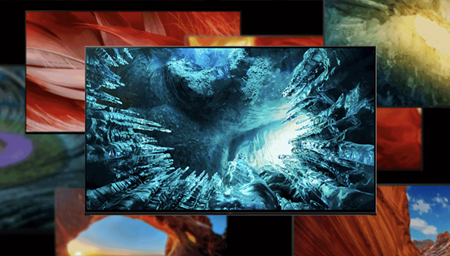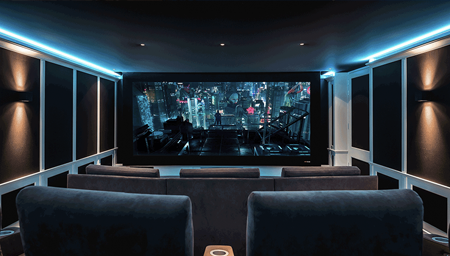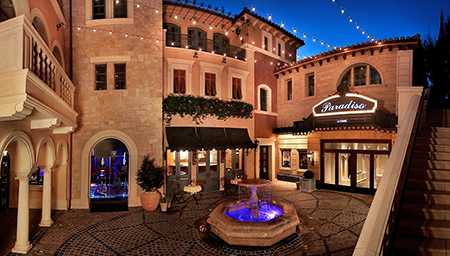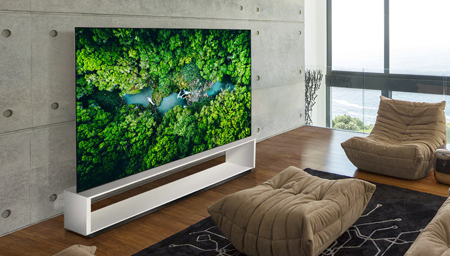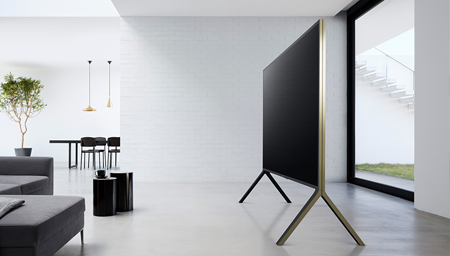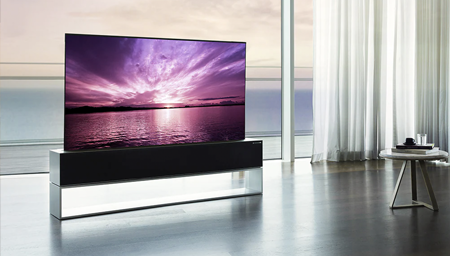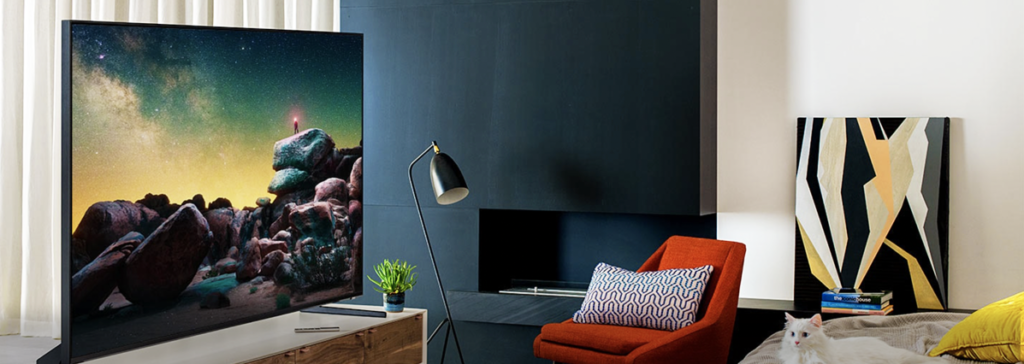
The Pros & Cons of Direct-Views TVs
Projectors are usually associated with premium entertainment spaces, but you can now find high-end flat-panel TVs as large as 100 inches
John Sciacca
updated December 15, 2020
In “The Pros & Cons of Projectors,” I detail the advantages and disadvantages of going with a front projector and screen as the video display in your media room/theater. Here we’ll dissect traditional direct-view flat-panel TVs to help determine whether they’re the right technology choice for your room.
PROS
They’re a complete solution
Unlike a projector, which is just a display device requiring amplification, speakers, sources, and a screen in order to perform, a direct-view TV can function entirely on its own. It has a built-in ATSC tuner for cable or off-air tuning, Wi-Fi access to the Internet for streaming Ultra HD content like Netflix, Amazon, and Disney+, and speakers to deliver audio. (Granted, the audio output of most TVs is abysmal, and any luxury cinema definitely includes a separate surround audio system of some caliber.) For those wanting the simplest turnkey option, a direct-view TV might be the right call.
Better performance at smaller screen sizes
Sometimes bigger isn’t better, and a 65-, 75-, or 85-inch screen might be the perfect size for your room. While you could get a projection screen that small, the performance tradeoffs just wouldn’t make sense. And the new Sony 100-inch display will certainly make a strong argument as a primary option for a media-room display. If you’re looking for a screen size sub-101 inches, direct-view is probably the right call.
Flagship performance at an affordable price
Projectors in the luxury market can easily cost $30,000 to $100,000 but a truly state-of-the-art direct-view LED or OLED set can be had for a fraction of that.
Easier to install
Since the electronics and power in many entertainment spaces are located near the TV, installation is far more straightforward. But since projectors are typically ceiling mounted on the other side of the room, it can be far more difficult to get power and other cabling to them in a retrofit situation. Obviously, if you’re building or remodeling a room, this will be less of a factor but in an existing space, a traditional display will almost always make for an easier installation.
Unaffected by ambient light
While even a single light bulb can be a detriment to a projector’s image, direct-view sets can happily exist in rooms with virtually any amount of light. If it isn’t practical to darken your space fully at all times of day, or you prefer doing your movie/TV watching or gaming with some lights on, direct-view sets will give you a lot more flexibility. Granted, TVs can have issues with reflections and color/light shift when viewing from wide seating positions, but these are often far easier to address than too much light on a projection screen.
Can accommodate HDR/Dolby Vision
To bear the Ultra HD Alliance’s “Premium” logo, a TV’s HDR (high dynamic range) technology must be able to simultaneously produce both exceedingly deep blacks and bright whites. This is a standard easily met by the current flock of LED and OLED displays, which continue to get both brighter and darker, producing absolute blacks that are unmeasurable. Projectors, on the other hand, can offer only a fraction of that level of performance. And no current home projector can handle the DolbyVision HDR standard, which uses metadata to adjust the dynamic range settings of a movie scene by scene. While projectors continue getting better at handling HDR content, they’ll likely always lag behind direct-view sets, which can produce a far brighter and punchier image.
Can produce 32 million pixels
As ridiculous as it sounds, especially since many people are just now considering the move to 4K sets, 8K displays will likely be leading the next wave of large displays. Never mind that most broadcast-content providers still can’t even deliver 1080p, let alone any quantity of 4K content outside the occasional special broadcast, and that there’s no solution even in the pipeline to actually deliver an 8K image outside of some YouTube content. All that aside, 8K is not only coming, it’s here, with LG, Sony, and Samsung all currently offering models. The 8K displays I’ve seen at tradeshows are nothing short of flat-out stunning but whether that was due to the oodles of extra pixels on screen, the fantastic video processing, or increased brightness capabilities, I can’t say. The likely scenario is the next generation of flagship direct-view sets will be 8K (7,680 x 4,320 pixels), and early indications are they will produce spectacular images even when upscaling native 4K content.
Faster upgrade cycle
Whereas projectors often live a pretty lengthy life cycle of three or more years between model updates, new flat-panel displays are introduced virtually every year. (The Consumer Electronics Show—CES—held in Las Vegas every January is the big coming-out party for nearly every display manufacturer.) Due to this, we see the latest and greatest technology, processing, and feature developments happening first in the display market and then shifting over to projectors during their next update.
CONS
More expensive for larger screens
While an 85-inch screen size is nothing to sneeze at, if you want to go larger than that, projection systems can actually be competitive. While you can get a great 85-inch set for under $5,000, prices go up considerably for sizes up to 100 inches. For example, the new 98-inch Samsung (shown at the top of the page) sells for $15,000, and the new Sony 100-inch goes for $20,000. If OLED is more your game, LG’s 88-inch Signature ZX 8K OLED will run you $30,000. And if you want to go larger than 100 inches, the options in direct-view become significantly more costly, with new microLED displays from Sony, LG, and Samsung carrying price tags that can literally run into the millions.
Room dominating
We’re a luxury website, so perhaps the prospect of dropping a ton of cash on a flagship direct-view set isn’t a deal killer. I mean, Ferrari is selling $300,000 488 GTBs faster than it can produce them, so clearly the luxury buyer is alive, well, and spending. But one thing you’ll have a tougher time doing with a massive direct-view set is hiding it or decorating around it. But this isn’t impossible. In fact, there are a lot of really great and unique installation options for flat-panel displays beyond using the simple tabletop stand or a traditional wall mount. Companies like Future Automation and Nexus 21 offer an amazing array of custom options that can make a flat panel disappear inside furniture or cabinetry, into floor or attic spaces, under beds, or about anything else you can imagine, and then “magically” appear at the press of a button. Another option to consider is LG’s new Signature OLED R with its unique rollable display that completely disappears when not in use.
Hinder speaker placement
The ideal speaker layout places the front left, center, and right speakers on the same horizontal plane as the center of the screen image, ensuring that sounds perfectly track the onscreen action. With an acoustically transparent projection screen, this isn’t a problem—and it keeps the front speakers completely out of sight—but with a massive direct-view set, placing the center-channel speaker correctly becomes more problematic. Generally, the solution is to install it below the screen, and while this often does a satisfactory job of marrying the dialogue to the screen, results can vary depending on how large your TV is, how low the speaker is installed, and how far the seats are from the screen.
Poor off-angle viewing
LED TVs can exhibit a real shift in image brightness, color accuracy, and picture quality as you start moving significantly away from the center. If your media room is wide, with seats at extreme angles from the screen, people in those seats may have a compromised experience. Also, glare and reflections can become an issue when sitting well off-center.
Choosing the right display technology is likely one of the biggest decisions you’ll make when creating a media or theater room, and being armed with all the information necessary to choose—along with finding a competent installer—will definitely make your system turn out to be the best it can. Discuss your design, decoration, and performance needs with your designer and installer, and you should be able to come with a solution that makes everyone happy!
Probably the most experienced writer on custom installation in the industry, John Sciacca is co-owner of Custom Theater & Audio in Murrells Inlet, South Carolina, & is known for his writing for such publications as Residential Systems and Sound & Vision. Follow him on Twitter at @SciaccaTweets and at johnsciacca.com.
© 2025 Cineluxe LLC


